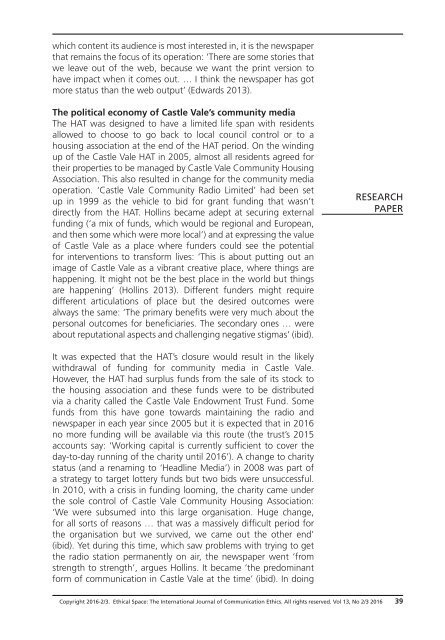Beyond clickbait and commerce
v13n2-3
v13n2-3
You also want an ePaper? Increase the reach of your titles
YUMPU automatically turns print PDFs into web optimized ePapers that Google loves.
which content its audience is most interested in, it is the newspaper<br />
that remains the focus of its operation: ‘There are some stories that<br />
we leave out of the web, because we want the print version to<br />
have impact when it comes out. … I think the newspaper has got<br />
more status than the web output’ (Edwards 2013).<br />
The political economy of Castle Vale’s community media<br />
The HAT was designed to have a limited life span with residents<br />
allowed to choose to go back to local council control or to a<br />
housing association at the end of the HAT period. On the winding<br />
up of the Castle Vale HAT in 2005, almost all residents agreed for<br />
their properties to be managed by Castle Vale Community Housing<br />
Association. This also resulted in change for the community media<br />
operation. ‘Castle Vale Community Radio Limited’ had been set<br />
up in 1999 as the vehicle to bid for grant funding that wasn’t<br />
directly from the HAT. Hollins became adept at securing external<br />
funding (‘a mix of funds, which would be regional <strong>and</strong> European,<br />
<strong>and</strong> then some which were more local’) <strong>and</strong> at expressing the value<br />
of Castle Vale as a place where funders could see the potential<br />
for interventions to transform lives: ‘This is about putting out an<br />
image of Castle Vale as a vibrant creative place, where things are<br />
happening. It might not be the best place in the world but things<br />
are happening’ (Hollins 2013). Different funders might require<br />
different articulations of place but the desired outcomes were<br />
always the same: ‘The primary benefits were very much about the<br />
personal outcomes for beneficiaries. The secondary ones … were<br />
about reputational aspects <strong>and</strong> challenging negative stigmas’ (ibid).<br />
RESEARCH<br />
PAPER<br />
It was expected that the HAT’s closure would result in the likely<br />
withdrawal of funding for community media in Castle Vale.<br />
However, the HAT had surplus funds from the sale of its stock to<br />
the housing association <strong>and</strong> these funds were to be distributed<br />
via a charity called the Castle Vale Endowment Trust Fund. Some<br />
funds from this have gone towards maintaining the radio <strong>and</strong><br />
newspaper in each year since 2005 but it is expected that in 2016<br />
no more funding will be available via this route (the trust’s 2015<br />
accounts say: ‘Working capital is currently sufficient to cover the<br />
day-to-day running of the charity until 2016’). A change to charity<br />
status (<strong>and</strong> a renaming to ‘Headline Media’) in 2008 was part of<br />
a strategy to target lottery funds but two bids were unsuccessful.<br />
In 2010, with a crisis in funding looming, the charity came under<br />
the sole control of Castle Vale Community Housing Association:<br />
‘We were subsumed into this large organisation. Huge change,<br />
for all sorts of reasons … that was a massively difficult period for<br />
the organisation but we survived, we came out the other end’<br />
(ibid). Yet during this time, which saw problems with trying to get<br />
the radio station permanently on air, the newspaper went ‘from<br />
strength to strength’, argues Hollins. It became ‘the predominant<br />
form of communication in Castle Vale at the time’ (ibid). In doing<br />
Copyright 2016-2/3. Ethical Space: The International Journal of Communication Ethics. All rights reserved. Vol 13, No 2/3 2016 39


